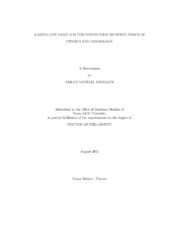| dc.contributor.advisor | Dutta, Bhaskar | |
| dc.creator | Krislock, Abram Michael | |
| dc.date.accessioned | 2012-10-19T15:29:10Z | |
| dc.date.accessioned | 2012-10-22T18:01:44Z | |
| dc.date.available | 2012-10-19T15:29:10Z | |
| dc.date.available | 2012-10-22T18:01:44Z | |
| dc.date.created | 2011-08 | |
| dc.date.issued | 2012-10-19 | |
| dc.date.submitted | August 2011 | |
| dc.identifier.uri | https://hdl.handle.net/1969.1/ETD-TAMU-2011-08-9998 | |
| dc.description.abstract | Dark matter has been shown to be extremely abundant in our universe. It comprises about 23 percent of the energy density of the entire universe, which is more than five times greater than the regular matter we already know about. Dark matter cannot be explained within the Standard Model of particle physics. However, models which extend the Standard Model, such as supersymmetry, can explain dark matter. This dissertation investigates the signals of some supersymmetry models in the context of collider physics. If dark matter particles or other supersymmetry particles are produced at some collider experiment, such as the Large Hadron Collider, it is important to know how we can find and measure the signatures and properties of these particles. This dissertation provides some measurement techniques for that exact purpose. These measurement techniques are also very general, making them useful for examining other models of particle physics as well. Lastly, if the supersymmetry model can be understood well enough from collider data, the connection back to cosmology can be made. Namely, it is possible to determine (from LHC data and using a standard cosmological calculation) the abundance of dark matter in the universe. Comparing this collider value with the value already measured will be a crucial step in understanding dark matter. This dissertation provides simulated results of this dark matter abundance calculation for a number of supersymmetry model points. | en |
| dc.format.mimetype | application/pdf | |
| dc.language.iso | en_US | |
| dc.subject | Dark Matter | en |
| dc.subject | High Energy Particle Physics | en |
| dc.subject | Cosmology | en |
| dc.subject | Particle Physics Cosmology Connection | en |
| dc.subject | Large Hadron Collider | en |
| dc.subject | Supersymmetry | en |
| dc.title | Making the Dark Matter Connection Between Particle Physics and Cosmology | en |
| dc.type | Thesis | en |
| thesis.degree.department | Physics and Astronomy | en |
| thesis.degree.discipline | Physics | en |
| thesis.degree.grantor | Texas A&M University | en |
| thesis.degree.name | Doctor of Philosophy | en |
| thesis.degree.level | Doctoral | en |
| dc.contributor.committeeMember | Kamon, Teruki | |
| dc.contributor.committeeMember | Nanopoulos, Dimitri | |
| dc.contributor.committeeMember | Fulling, Stephen | |
| dc.type.genre | thesis | en |
| dc.type.material | text | en |


